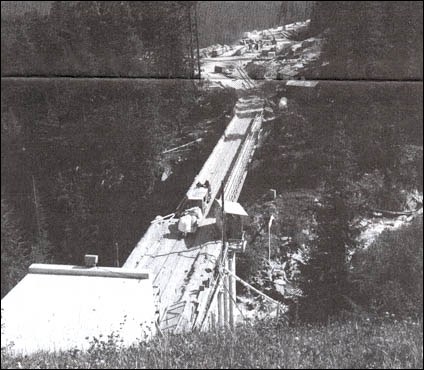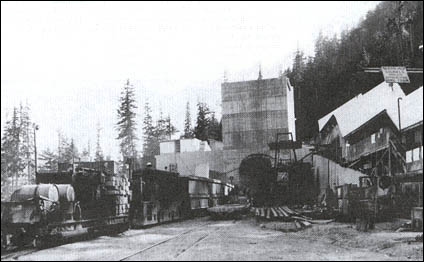Vol. 17 No. 12
December, 1987
|
Stay Safe in 87
|
|
Like the Pieces of a Huge Puzzle Project is Coming
Together
By Steve Morris

Overlooking Bear Pit:
Looking westward from the top of Mount Shaughnessy Tunnel, the new line, when completed in mid-1988,
will travel over the Connaught Creek bridge and a huge depression known as the Bear
Pit.
 Rogers Pass B.C. - As the fourth consecutive
construction season on the Rogers Pass Project draws to a close, workers here are really seeing the fruits of their
labours. Rogers Pass B.C. - As the fourth consecutive
construction season on the Rogers Pass Project draws to a close, workers here are really seeing the fruits of their
labours.
The multi-phased project is the largest of its kind in North America and the biggest undertaking the
railway as made since completion of the transcontinental main line in 1885.
This year, the 15 kilometres of surface route, which starts at the bottom of the Beaver Valley at the Rogers Pusher
Station and extends to the slopes of Mount Shaughnessy at the base of Rogers Pass, was completed.
"All the construction pieces of the puzzle that makes up the Rogers Pass Project are starting to come
together", said John Fox, vice-president, special projects.
SURFACE ROUTE
"The surface route is virtually complete except for a small portion between the two tunnels and at the west
portal of Mount Macdonald".
In the fall of 1986, 12.7 kilometres of rail was installed between the Pusher Station and Stoney Creek.
This was done to permit construction crews to move in necessary equipment and 45 bridge spans that make up the
1,229-metre long viaduct.
"It was vital to have the rail line in by the end of last year because there was no other viable method of
transporting the bridge spans from Calgary to the Rogers Pass site other than by rail", Mr. Fox said.
In May this year, two special trains were dispatched from Calgary with the spans. The trains were the longest of
their kind ever moved by a Canadian railway.
DETOURED SPANS
Because of the size of the spans - each measured some 27.2 metres long and weighed 8.2 tonnes - the special trains
had to be detoured an additional 400-kilometres from Calgary through southern Alberta and British
Columbia, then through the Crowsnest Pass where they rejoined the main line at Golden, B.C.
This routing was necessary because the spans would not clear tunnels between Field and Golden.
While the spans were being loaded and shipped, crews began assembling a special machine called a launcher at the
east abutment to the viaduct. Not since the days of the building of the Lethbridge Viaduct or the High Level Bridge
in edmonton had a machine like this been used on CP Rail.
"We had to use a launcher for many reasons but the main one was because of the limited access to the viaduct
site", Mr. Fox explained.
"The spans were brought in by rail as far as Stoney Creek and then off-loaded onto a flat bed truck
that had steerable rear wheels. From there the truck backed down to the viaduct and fed the spans into the launcher.
Using a moveable crane system, the launcher would pick up the span from the flatbed and then extend it out from one
pier to the next. Once the span was in place, the launcher would travel along the completed span and wait for the
truck to bring the next one.
By the end of September the viaduct was completed with rail, ties, and ballast. In addition, crews had completed
reclamation and reforestation work over most of the surface route.
The only three access roads to the surface route site - at Rogers, Mountain Creek, and Stoney Creek - were reclaimed.
Seeding and tree planting removed any trace that CP Rail had been there.
The 1987 construction season also saw Manning-Kumagai work crews break through the
1.6-kilometre Mount Shaughnessy Tunnel in May. Crews have taken the top portion out and are now
concentrating on removing the bottom few metres, referred to as the bench.
REMOVING BENCH
Selkirk Tunnel Constructors who are working from the east end of the tunnel, also have been taking out the bottom
portion or bench. this was necessary because they used a tunnel boring machine, with its circular cutting head, for
the main excavation. Crews finished blasting the balance of the tunnel into its final shape in late November.
Selkirk have also started lining the east end of the tunnel with concrete and are installing the
sub-invert, or concrete floor, which contains the tunnel drainage system.
On the west end, Manning-Kumagai are busy constructing the 25-metre high gate building
inside the mountain near the middle of the tunnel. The mammoth building will house the two large gates, or doors,
that are an integral part of the ventilation system.
Crews are also putting the finishing touches to two air tunnels that run on either side of the gate building and
connect the main tunnel with the ventilation shaft.
"PACT TRACK"
"The schedule will see the two major tunnel contractors finish the tunnel by the middle of 1988", Mr. Fox
said. "That will leave only signal and sensor systems and the concrete rail bed known as "Pact Track"
to be installed".
At the summit of Rogers Pass, work on the 349-metre deep ventilation shaft was completed in May. A new
contractor, PCL Industrial Contractors, handled the work on the 3,100-square-metre ventilation building
that is the heart and soul of the long tunnel's unique ventilation system.
RACING SNOW
"It was important for the contractor to have the outer shell of the building completed by the end of October
when snows usually come to Rogers Pass", Mr. Fox said. "This permitted crews to continue working inside
installing generators and other equipment.
The Rogers Pass Project continues to be a major employer for various construction trades in British Columbia. In
1987, the project employed an average of 700 people.
"The economic spin-offsto local communities has been tremendous", Mr. Fox said. "Local
contractors, ranging from truckers to hardware stores and suppliers, have benefitted".
The railway mega-project is expected to be completed next year.
CP Rail Special Project engineers expect to begin operating test trains over the new line in the fall. Regular
freight trains are expected to begin using the new line by the end of 1988.

At the East Portal: The east
portal of the Mount Macdonald Tunnel, the longest railway tunnel in North America, features a gate building for
tunnel doors and a fan building for ventilation purposes.
This CP Rail News article is copyright
1987 by the Canadian Pacific Railway and is reprinted here with
their permission. All photographs, logos, and trademarks are the property of the Canadian Pacific Railway
Company.
|